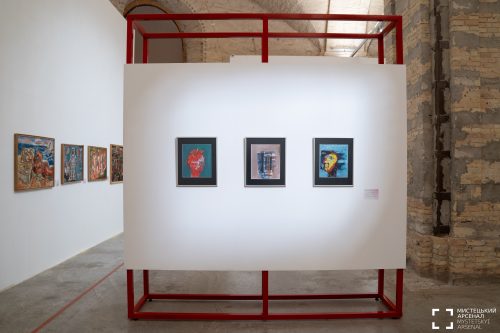From the Series “1000 Heads”Exhibitions
-
-
Search for an exhibition
-
- Search
Name
From the Series “1000 Heads”
Author
Yurii Solovii
Date of creation
The 1970s
Material
Paper, author's technique
Yurii Solovii (1921, Staryi Sambir — 2007, Rutherford) was one of the leading figures in modern Ukrainian culture that due to rather tragic circumstances developed mainly outside Ukraine. His biography is similar to thousands of biographies of other Ukrainian emigrants of the third wave (1940-1954) that consisted of people who found themselves outside Ukraine as a result of World War II and refused to return. After the war, most of them were initially in camps for displaced persons and prisoners of war, and then settled down in various countries of Western Europe, as well as on American and Australian continents. Yurii Solovii emigrated to Germany, and later moved to the United States. However, among the many talented Ukrainians scattered around the world, he is distinguished by a peculiar intellectual and spiritual self-sufficiency. Therefore, his work is not marked by nostalgia; he lives not in the past that is irretrievably lost, but seeks to integrate into the modern artistic environment. In the spectrum of Ukrainian modernism, Solovii is a brilliant follower of neo-expressionism. He is interested in two extremes of human existence: birth and death; and between them Solovii sees mostly suffering. The artist expresses these motives using religious symbols. For instance, the artist’s monumental work Crucifix, where he is focused on depicting bodily deformities. He does not glorify Christ, but rather rebukes him for his weakness. Such an interpretation by the artist, which equated Christ with an ordinary man, provoked discussions and protests at the time because of the distortion of the canonical image.
In addition to Crucifix, the exhibition also presents The Birth, an early painting by Yurii Solovii, where the artist uses muted colors to emphasize the fragility of the human body at birth and death.
The Series “1000 Heads” is very important in the artist’s work; he began working on it in the early 1970s. The artist decided to paint a thousand heads, using the widest variety of techniques and materials: oil, watercolor, pencil, ink, plastic, hair, paper. The heads are abstract, but some of them are recognizable — Jesus Christ, Van Gogh, Venus etc. Solovii did not have time to finish the series. In the early 1990s, Solovii suffered a mild stroke; he fell on stone stairs and hit his head. At the hospital, a third of his brain was removed, and he was in a coma for two years. All the doctors thought that he would never get out of it. But despite everything, Solovii came out of a coma. He remembered all the languages he knew, remembered all his friends, but he lost his dynamism, curiosity and the need to fight with life, and never returned to art.
Based on: Bohdan Boichuk. Yurii Solovii iz dalekoi perspektyvy // Den. – February 22, 2007


